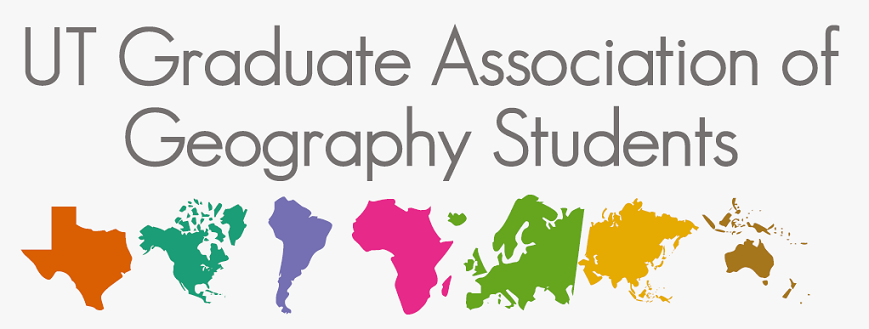Doctoral candidates Naya Jones and Bisola Falola co-organized and chaired two sessions at the 2012 Race, Ethnicity, and Place Conference (hosted in part by the Ethnic Geography Specialty Group of AAG) in San Juan, Puerto Rico.
Both sessions were titled: (En)countering Space, Place, and Agency: Everyday Youth Geographies
Naya presented: Of Soul Food and Barbacoa: Black and Latin@ Youth, Food, and Intersubjectivity
Bisola presented: Entangled Emotions: Connecting the Links between Race, Emotional Landscapes, and Youths’ Future Expectations
The sessions were well attended and had engaging discussions!
Tuesday, October 30, 2012
Sunday, October 28, 2012
Students and faculty present at annual SWAAG meeting in Las Cruces, NM
Department of Geography and the Environment graduate students and
faculty members traveled to Las Cruces, NM, last week to present their research at the annual meeting of the Southwestern Division of
the Association of American Geographers (SWAAG). Congratulations to the
presenters for their hard work!
The Case of the Missing Laureate: The Communication Geography of the 2010 Nobel
Peace Prize; Dr. Paul Adams
Rural-to-Rural Trading in the City: Artisanal Sugarcane Liquor Commercialization in
the Northeastern Peruvian Amazon; Mario Cardozo
Spatial Analysis of Woody Species in Northwest Botswana; Thomas Christiansen
An Evolving Home: Communal Vision and Changing Livelihood in an Amazonian
Religious Community; Jonathan Lowell*
Land Cover Change in Seronga, Botswana Between 2003 and 2011; Xuebin Yang*
*denotes participation in student competitions
The Case of the Missing Laureate: The Communication Geography of the 2010 Nobel
Peace Prize; Dr. Paul Adams
Rural-to-Rural Trading in the City: Artisanal Sugarcane Liquor Commercialization in
the Northeastern Peruvian Amazon; Mario Cardozo
Spatial Analysis of Woody Species in Northwest Botswana; Thomas Christiansen
An Evolving Home: Communal Vision and Changing Livelihood in an Amazonian
Religious Community; Jonathan Lowell*
Land Cover Change in Seronga, Botswana Between 2003 and 2011; Xuebin Yang*
*denotes participation in student competitions
 |
| Graduate students at White Sands National Monument, New Mexico |
Monday, October 8, 2012
[in print] Recent Publications from Matt LaFevor and Niti Mishra
Doctoral candidates Matt LaFevor and Niti Mishra have new publications available. Follow the links below for the full text of each article.
 LaFevor, M. 2012. Sulphur Mining on Mexico’s Popocatépetl Volcano (1820-1920): Origins, Development, and Human- Environmental Challenges. Journal of Latin American Geography. 11(1): 79-98.
LaFevor, M. 2012. Sulphur Mining on Mexico’s Popocatépetl Volcano (1820-1920): Origins, Development, and Human- Environmental Challenges. Journal of Latin American Geography. 11(1): 79-98.
This paper traces the origins and development of a little-known extractive industry in nineteenth-century Mexico: volcanic sulphur mining. Unpublished documents from Mexican archives, nineteenth-century travel literature, reports from early scientific expeditions, and historical newspapers provide the bulk of data. Documents show how both Mexican and United States interests – indigenous sulphur miners (azufreros) and venture capitalists – confronted the challenges of mining sulphur from the crater of Mexico’s Popocatépetl volcano, at 5,426 meters (17,802 feet) elevation.
.

LaFevor, M. 2012. Building a Colonial Resource Monopoly: The Expansion of Sulphur Mining in New Spain (1600-1820). Geographical Review. 102(2): 202-224.
The discovery, extraction, and monopolistic control of key natural
resources was a priority of New Spain's colonial administration.
Managing the region's abundant resources, however, often proved
difficult for the Spanish Crown. Human and environmental challenges
impeded protoindustrial growth and development, and monopolistic control
of resources often met resistance. In this article I examine these
processes in the context of New Spain's little-known monopoly on
sulphur—a yellow, powdery mineral the Crown jealously guarded as its
own.

Mishra, N. B., Crews, K. A., & Neuenschwander, A. L. (2012).Sensitivity of EVI-based harmonic regression to temporal resolution in the lower Okavango Delta. International Journal of Remote Sensing. 33(24), 7703–7726.
In this study, we examined how satellite time-series-based characterization of ecological cycles and trends is sensitive to the temporal depth and spacing of the time series and whether the observed sensitivities were cover and/or cycle specific. The results show that as the temporal depth decreases, the sensitivity to both short- and long-term ecological cycles was lost in the seasonally dynamic environment.
 LaFevor, M. 2012. Sulphur Mining on Mexico’s Popocatépetl Volcano (1820-1920): Origins, Development, and Human- Environmental Challenges. Journal of Latin American Geography. 11(1): 79-98.
LaFevor, M. 2012. Sulphur Mining on Mexico’s Popocatépetl Volcano (1820-1920): Origins, Development, and Human- Environmental Challenges. Journal of Latin American Geography. 11(1): 79-98.This paper traces the origins and development of a little-known extractive industry in nineteenth-century Mexico: volcanic sulphur mining. Unpublished documents from Mexican archives, nineteenth-century travel literature, reports from early scientific expeditions, and historical newspapers provide the bulk of data. Documents show how both Mexican and United States interests – indigenous sulphur miners (azufreros) and venture capitalists – confronted the challenges of mining sulphur from the crater of Mexico’s Popocatépetl volcano, at 5,426 meters (17,802 feet) elevation.
.

LaFevor, M. 2012. Building a Colonial Resource Monopoly: The Expansion of Sulphur Mining in New Spain (1600-1820). Geographical Review. 102(2): 202-224.

Mishra, N. B., Crews, K. A., & Neuenschwander, A. L. (2012).Sensitivity of EVI-based harmonic regression to temporal resolution in the lower Okavango Delta. International Journal of Remote Sensing. 33(24), 7703–7726.
In this study, we examined how satellite time-series-based characterization of ecological cycles and trends is sensitive to the temporal depth and spacing of the time series and whether the observed sensitivities were cover and/or cycle specific. The results show that as the temporal depth decreases, the sensitivity to both short- and long-term ecological cycles was lost in the seasonally dynamic environment.
Subscribe to:
Posts (Atom)

